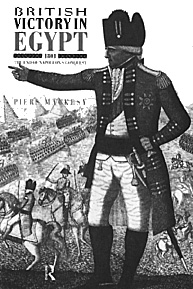
 Author: Mackesy, Piers
Author: Mackesy, Piers Pages: 282
Illustrations: none
Maps: 12, from strategic to battle maps with details down to brigade level
Footnotes: 526 in 23 pages
Appendices: none
Bibliography: 60 manuscripts and 123 other sources listed
Index: 476 items in 9 pages
Publisher: Routledge
Publication Date: 1995
Binding: Cloth (Hardcover)
ISBN: 0-415-04064-7
Price: $79.95
Summary: Despite the decidedly one-sided collection of research materials and truncated attention to French activities during the campaign, this book is an exceptionally enjoyable read.
This is the first English work that I'm aware of published in the last several decades on any aspect of Napoleon's Egyptian campaign. It starts with a detailed discussion of the status of the British army as it stood after the American Revolution and prior to the Egyptian campaign. For those of you who don't know it, the British army was at its nadir, having been chased out of Holland by the French and generally derided by the Navy as being incompetent. Mackesy devotes a considerable portion of his first chapter to an explanation of the development of Dundas' famous drill regulations. This discussion also includes a substantial biographical sketch of Sir Ralph Abercromby.
From there Mackesy goes into a thorough discussion of the organization of the Egyptian expedition and its journeys as it moved to its target, A1exandria. He covers information on the Turkish Empire that it was hoped would support Abercromby, as well as a discussion of the reforming of the British army's specific training in preparation for this invasion.
It is at this point where the book steps from the typical into the extraordinary. What follows is a highly detailed discussion of the various battles that eventually led to the collapse of the French Army of the Orient. There are several highly detailed battle maps, supported by detailed orders of battle, and a well-written and detailed discussion of each battle (several of which would provide ideal scenarios for any wargamer).
On the other hand, it is also here that it becomes apparent that Mackesy depended almost entirely on English source documents. There is a decided lack of detail on the French activities. This may well flow from Mackesy's anglophilia, but I think this flaw comes from a failure to consult French sources. Mackesy has a substantial list of original manuscripts, all by Englishmen, and four pages listing the printed documents that he consulted. Only ten or eleven French titles could be found in a list of some 100 or more English documents.
In his conclusion, Mackesy reviews the fate of every senior British officer who took part in the campaign. Though such generals as Reynier, Friant, Lagrange, Bertrand, and Latour-Maubourg were there and are discussed, Mackesy spends more time discussing the career of three British regimental officers.
I will admit to being annoyed by his occasional use of anachronistic words, such as "hump" to describe soldiers carrying heavy loads, and "groupies" to describe fans of an individual of note, but I still strongly recommend this work to all students of the Napoleonic and French Revolutionary Wars.
Reviewed by George Nafziger
Back to Table of Contents -- Napoleon #1
Copyright 1995 by Emperor's Press.